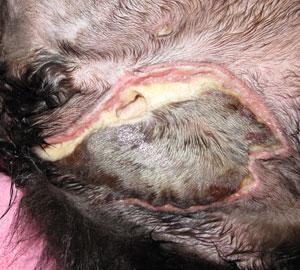Abscesses and cellulitis resulting from cat bites are a common infectious disease scenario presented to veterinary hospitals. Microbes are inoculated into subcutaneous and deeper tissue through wounds caused by feline canine teeth.
Crushing injury from the bite also further devitalizes the surrounding tissue and the wounds will primarily close when the tooth exits, creating an environment that most microbes can thrive in. The predominant majority of organisms found are obligate and facultative anaerobes, including Actinomycesspecies, Pasteurella species, Bacteroides species and Fusobacterium species. Such organisms are most commonly susceptible to β-lactam antibiotics like amoxicillin.
The authors wanted to determine whether Mycoplasma species are common contaminants of cat bite abscesses and whether these organisms are more associated with β-lactam-resistant clinical disease. One reason they evaluated Mycoplasma species in this situation is that these organisms are cell wall-deficient and are also normal flora found in the cat mouth. Included in the study were 26 privately owned cats with evidence of an abscess believed to be caused by a cat bite. Samples were taken from each cat for evaluation by aerobic and anaerobic culture along with Mycoplasma species culture and polymerase chain reaction (PCR).
Samples from 23 of 26 cats in the study were positive for at least one bacterium. 15 samples grew anaerobic and facultative anaerobic bacteria, 5 samples grew aerobic and anaerobic bacteria, 2 grew aerobic bacteria alone, and 1 sample grew Mycoplasma species and an anaerobic bacterium. Mycoplasma species DNA was PCR positive in 4 of 26 samples (15.6%). The aerobic bacteria most commonly found were Bacillus species and Corynebacterium species.
All 26 cats were provided surgical drainage and wound lavage along with being administered either amoxicillin, amoxicillin clavulanate (Clavamox®) for 7 days or cefovecin sodium (Convenia®) SC once. 25 of the 26 cats responded to the initial treatment by day 7. The cats responding to this treatment included 3 of 4 Mycoplasma species PCR-positive cats. The one cat that failed initial treatment was positive for Mycoplasma equigenitalium or M elephantis. The patient subsequently responded to treatment with enrofloxacin and clindamycin.
Because Mycoplasma species are difficult to culture, this microbe may be unnoticed as a causative agent in a cat bite-related infection. This type of infection with Mycoplasma species appears to be relatively uncommon, they can contaminate cat bite abscesses (15.6% in this study). In the end, routine wound care management and antibiotic therapy appears to be adequate for treatment and control of most cases in cats.
